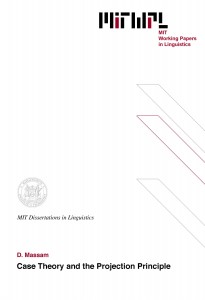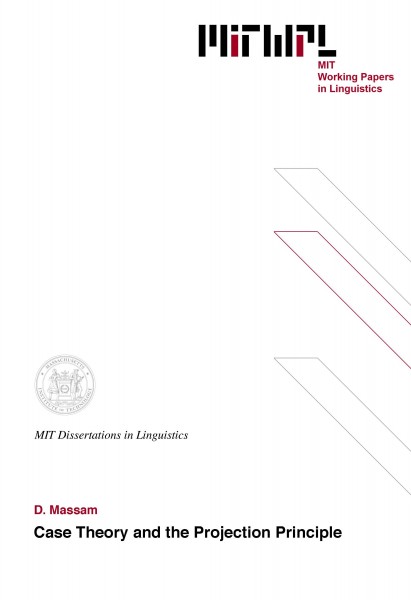Case Theory and the Projection Principle
D. Massam, 1985
We examine structures in which an NP bears a grammatical relation to a verb, to which it bears no thematic relation. We see several semantic classes of verbs appearing in such constructions, and a number of different types of such constructions, but no systematic relation between the semantic class of the verb and the syntactic type of construction in which it appears.
To explain mapping between thematic structure and grammatical structure, we assume the Projection Principle (PP), which states that syntactic structure must reflect lexical properties (thematic structure/predicate"subject relations) at all levels. The PP appears to be violated by structures with non-thematic "objects" coreferential with an embedded subject, object, or oblique NP (=NP-th). We examine data showing that although the NP acts as an object, it is not outside of the clause containing NP-th. It is in an embedded initial A-bar position, acting as a predicate subject for the constituent containing NP-th. It acts as an object of the matrix clause due to government holding between a verb and complement and certain elements in the complement.
A second aspect of a theory of grammar is licensing of NPs for interpretation. Elements in A-positions are licensed by Case, an abstract relation holding between arguments and governors. Given A-bar subject positions, the domain of Case requirement is not A-positions, but rahter, all positions governed by the PP: subjects and complements. Projection and Case are intertwined facets of interpretability.
In Chapter 1 we introduce the domain of exploration. In Chapter 2 we consider "raising to object" constructions. Certain English, Hindi, Icelandic verbs effect sentential Exceptional Case Marking (=S/ECM) by subcategorization for "INFL-phrase", with government and Case to the specifier. In Romance, different ECM structures arise with verbs selecting for a Case assigning head. Hungarian structures support our claims. "Non-vacuous" ECM in Blackfoot, Fijian, James Bay Cree, Kipsigas, Moroccan Arabic, Niuean, Standard Arabic, argues for embedded A-bar subjects.
In Chapter 3 we look at non-thematic subjects (NTS). An NP may come to act as a NTS in one of three ways. Raising to subject is examined in English. Kipsigas, and James Bay Cree NTS structures involve operator movement, as does "tough movement" in many languages. We thus divide the theta-criterion into two parts, one holding at all levels and one at LF, and introduce a licensing device of composed theta chains. Niuean and Standard Arabic show that NTS structures arise under non-Case assigning verbs which allow A-bar subjects. Passive ECM verbs in these languages are identical to Raising and Subject verbs, as they are, in a different way, in English.
In Chapter 4, NP complements in Chickasaw, Hungarian, Romanian, Kinyarwanda, Turkish substantiates our claims, as verbs ECM the A or A-bar possessor subjects of NPs, (=NP/ECM). The distribution of NP/ECM across languages argues that Cases exist independently of Case assignment, since NP/ECM requires the existence of an extra Case, as predicted by the Case Filter. NP/ECM allows for direct argument possessors, or indirect argument possessors. We predict that NP/ECM occurs only into object NPs. Several apparent exceptions actually support our claims.
In Chapter 5 case and chain theory is presented (Levin & Massam, 1984), accounting for expletive distribution, Case/argument structure relations of Burzio"s (1981) Generalization, and the Nom/Acc, Erg/Abs parameter. The theory is revised to embrace data of this study, and we define Case requirements in terms of the Projection Principle.
We close with a typology which emerges from our study.
Thesis Supervisor: Noam Chomsky
Title: Institute Professor
Table of Contents
Chapter 1 Introduction 14
1.1 Overview 14
1.2 Crucial notions 20
1.3 Outline 25
1.3.1 Chapter 2 26
1.3.2 Chapter 3 28
1.3.3 Chapter 4 30
1.3.4 Chapter 5 33
Chapter 2 Exceptional Case marking: a case of Case to Specifiers 34
2.1 Introduction 34
2.1.1 Overview of Chapter 2 34
2.1.2 Organization of Chapter 2 38
2.2 ECM with IP subcategorization 41
2.2.1 English data 41
2.2.2 ECM analysis 42
2.2.3 Case assignment to Spec: English 46
2.2.3.1 The prediction 46
2.2.3.2 Case resistance: tensed clauses 48
2.2.3.3 Case resistance: infinitival clauses 50
2.2.3.4 Non case resistance: wh-clauses 51
2.2.3.5 Case assignment to traces in SPEC 57
2.2.3.6 Conclusion 60
2.2.4 Other cases of IP-ECM 60
2.2.4.1 Hindi ECM 60
2.2.4.2 Icelandic ECM 66
2.3 Case assignment to SPEC: Hungarian 68
2.4 Case assignment to specifier of IP: Romance 71
2.4.1 Italian and French ECM 71
2.4.2 Italian and Portuguese aux fronting 74
2.4.3 The proposal 79
2.4.4 Interaction with operators 83
2.4.5 Conclusion 86
2.5 Non string-vacuous ECM 87
2.5.1 Introduction 87
2.5.2 Fijian and Niuean data 89
2.5.2.1 General data 89
2.5.2.2 ECM data 92
2.5.3 ECM: the analysis 99
2.5.3.1 The structure 99
2.5.3.2 A note on Niuean word order 100
2.5.4 Objections to direct raising to object 102
2.5.4.1 Raising to object vs ECM 102
2.5.4.2 Case and chain theory 103
2.5.4.3 Binding theory 107
2.5.5 ECM movement vs topicalization and left dislocation 115
2.5.5.1 A-bar/A relations 115
2.5.5.2 Topicalization and ECM movement 119
2.5.5.3 Left dislocation and ECM movement 123
2.5.6 ECM relations 132
2.5.6.1 French "avoir" constructions 133
2.5.6.2 The SPEC2/Theta-NP relation 135
2.5.6.3 Extraposition of CP in Fijian 145
2.5.6.4 ECM analysis: conclusion 146
2.5.7 Objections to indirect raising to object 150
2.5.7.1 The two-step analysis 150
2.5.7.2 Kipsigas data 151
2.5.8 Objections to "Prolepsis" 158
2.5.8.1 Introduction 158
2.5.8.2 Higgins (1981) for Prolepsis 160
2.5.8.3 Gordon (1980), Seiter (1980) against Prolepsis 169
2.5.8.4 Non-prolepsis in Moroccan Arabic 173
2.5.8.5 "Verb-of-NP-that-S" in English 180
Chapter 3 Non thematic subjects 186
3.1 Introduction 186
3.2 Non-thematic subjects via raising 187
3.3 Non-thematic subjects via tough movement 190
3.3.1 Kipsigas non-thematic subjects 190
3.3.2 English tough movement 199
3.3.3 Kipsigas non-thematic subjects via tough movement 212
3.4 Non-thematic subjects via ECM movement 213
3.4.1 Niuean movement to subject 213
3.4.2 Analysis and implications 221
3.4.3 Conclusion 234
Chapter 4 "Possessor raising": ECM into NPs 236
4.1 Introduction 236
4.1.1 Overview of Chapter 4 236
4.1.2 Organization of Chapter 4 242
4.2 NP/ECM: the possessor as direct verbal argument 243
4.2.1 Kinyarwanda data 244
4.2.1.1 The verb phrase 244
4.2.1.2 The noun phrase 250
4.2.2 Inherent and structural case and the uniformity condition 255
4.2.3 Kinyarwanda case marking and the uniformity condition 259
4.2.3.1 Inherent and structural case in Kinyarwanda 259
4.2.3.2 Kinyarwanda genitive case and the uniformity
condition 269
4.2.4 NP/ECM with double case marking 271
4.2.4.1 Tzotzil NP/ECM 271
4.2.4.2 Constituency in Tzotzil 275
4.2.4.3 Problems of double case marking 279
4.3 NP/ECM to specifiers of subjects 282
4.3.1 Introduction 282
4.3.2 Chickasaw NP/ECM: the data 284
4.3.3 The ergativity of Chickasaw NP/ECM 290
4.3.4 Multiple NP/ECM in Chickasaw 294
4.3.4.1 NP/ECM structures 294
4.3.4.2 Case assignment as linking 298
4.3.4.3 Conclusion so far 301
4.3.5 Chickasaw NP/ECM and the projection principle 304
4.4 NP/ECM: the possessor as indirect verbal argument 310
4.4.1 Hungarian NP/ECM 310
4.4.1.1 Szabolcsi (1981, 1983) 310
4.4.1.2 Problems 317
4.4.1.3 Revisions 319
4.4.1.4 The structure of Hungarian NPs 319
4.4.1.5 Case uniqueness 324
4.4.2 Other languages 328
4.4.2.1 Romanian 328
4.4.2.2 Chickasaw and Choctaw (objects) 331
4.5 Inalienable NP/ECM 336
4.5.1 Introduction 336
4.5.2 Inalienables as datives: Kinyarwanda 337
4.5.2.1 Kinyarwanda inalienable NP/ECM 337
4.5.2.2 Dative case NP/ECM 341
4.5.3 Korean "take-away" verbs 342
4.5.4 Some questions 345
4.5.5 Turkish S/NP//ECM and inalienable possession 350
4.5.5.1 Turkish ECM 350
4.5.5.2 Speculations 354
Chapter 5 Case theory 356
5.1 Introduction 356
5.2 Levin and Massam (1984) 356
5.2.1 The Nom/Acc//Erg/Abs parameter 357
5.2.2 Case theory 358
5.2.3 Burzio"s Generalization 364
5.3 Case theory and the projection principle 371
5.3.1 The problem 371
5.3.2 Revised case theory 373
Conclusion Typology 380
1 Introduction 380
2 A typology 382
Appendix I: Gloss glossary 386

